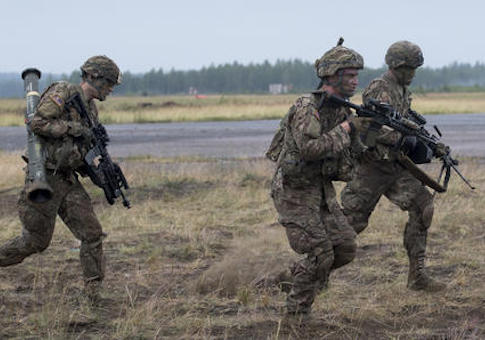The U.S. military has reported persistently low readiness levels as threats from Russia and China have demanded increased American presence in Europe and the Asia-Pacific region, according to a government watchdog.
The Pentagon lacks a comprehensive plan to rebuild readiness across the force as manpower and spending cuts have threatened the armed services’ preparedness for commitments abroad, concluded a Government Accountability Office report publicly issued on Wednesday.
The military services expect low levels of readiness to persist into the next decade, according to interviews conducted by auditors.
"The military services have reported persistently low readiness levels, which they have attributed to emerging and continued demands on their forces, reduced force structure, and increased frequency and length of deployments," the GAO wrote in the report.
Between fiscal years 2013-16, the active component end strength decreased by about 7 percent across the force and the reserve component end strength by 4 percent, according to the GAO.
The Department of Defense has also faced spending cuts across the board due to sequestration, which kicked in more than three years ago.
Service leaders have warned about reductions in force structure and budgetary constraints.
The U.S. Navy, for example, has been allocated $30 billion less than it has requested over the last four years, according to congressional testimony delivered earlier this year by Adm. John Richardson, chief of naval operations. The Navy has also seen an 18 percent decrease in its fleet of ships over the last two decades, according to the GAO, which has resulted in increased deployment lengths for its naval craft.
The Army and Marine Corps have each undergone years-long drawdowns of active duty members. The Obama administration plans to decrease the number of active-duty Army soldiers from 490,000 to 450,000 by the end of 2016. The count of Marine Corps personnel will also drop to 182,000 by the end of this year, which the Marine commandant recently described as a "red line" for the service.
Gen. David Goldfein, the new Air Force chief of staff, said in June that the Air Force is short about 4,000 active-duty airmen at the current decades-low level of 311,000. While the service is expected to increase the number of airmen to 317,000 by the end of the year, the Air Force secretary has said the service will need thousands more to ease current strains on the service.
In the face of reductions in budgets and manpower, overall demand for forces has remained high despite reduced commitments in Iraq and Afghanistan during the Obama administration. Combatant command officials who spoke to auditors emphasized the growing demand for forces in Europe and the Asia-Pacific region.
"For example, U.S. European Command officials noted that the command’s assigned forces are now staying in Europe and being used to meet the growing needs of the command, such as the response to Russian aggression, which officials noted has been the most significant driver of changes to the command’s needs since February 2014," auditors wrote.
"Moreover, U.S. Pacific Command officials noted that their operational requirements have steadily increased to ensure adequate capability exists to address increasingly unpredictable and provocative actions of North Korea and China," they wrote.
The services’ plans to resolve persistent readiness challenges have fallen short, according to the GAO report, which faulted the Pentagon for exercising insufficient oversight of efforts to rebuild readiness across the force.
While the Defense Department has made rebuilding readiness a priority, the department lacks a comprehensive plan for recovering readiness with long-term goals and ways to measure progress.
"Without metrics against which to measure the services’ progress toward agreed-upon, achievable readiness recovery goals, DOD will be unable to determine the effectiveness of readiness recovery efforts to assess its ability to meet the demands of the National Military Strategy, which may be at risk," auditors concluded.
Lawmakers appropriated $1 billion into a warfighting account for the Defense Department’s readiness improvement efforts during the current fiscal year.
The GAO was mandated by Congress to review the Pentagon’s efforts to rebuild military readiness. Auditors delivered a classified version of the report to congressional lawmakers in June, a "secret" assessment that provided greater detail of classified readiness assessments made by the Joint Chiefs of Staff and military commanders.
"The high pace of operations has created challenges for the all-volunteer force in its ability to respond to current demands," GAO auditors wrote in a note to congressional defense committees accompanying the report.
"The global security environment will likely continue to require significant reliance on U.S. military forces to respond to a range of demands even as the department faces a period of budget constraints including across-the-board spending reductions through sequestration and force structure reductions. As a result, DOD must ensure that the force is poised to meet a range of global needs," they wrote.
The Pentagon, which concurred with the watchdog’s recommendations to establish a comprehensive plan for recovering readiness, did not respond to a request for comment.
